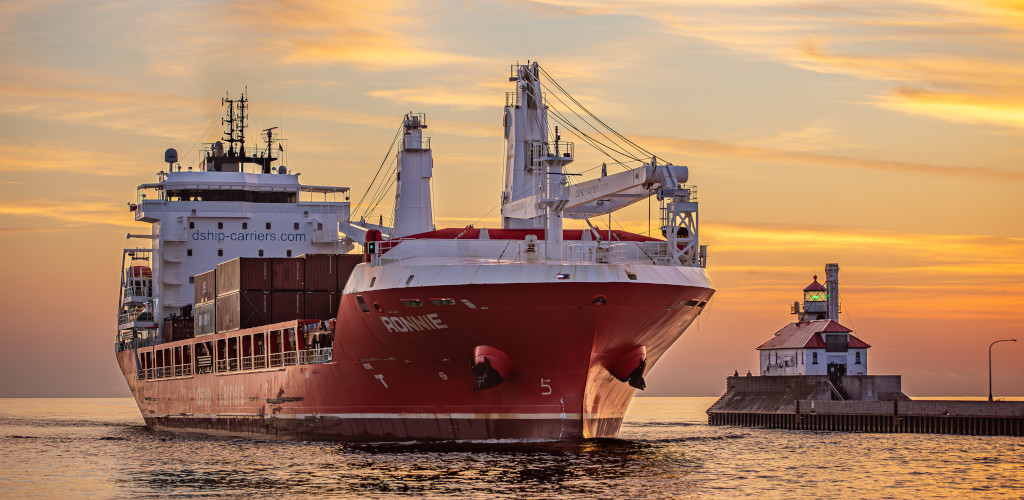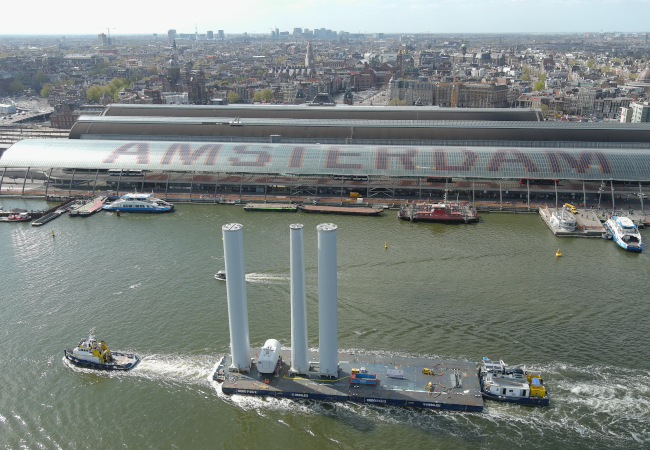Bumper Profits Drive Fleet Renewal Investment, Though Doubts Remain Over Alternative Fuels

By Felicity Landon
As European shortsea shipping gains momentum, how are ports and other industry players driving the creation of new green corridors to decarbonize maritime transport?
From Issue 4, 2024 of Breakbulk Magazine.
(8-minute read)
Shortsea shipping is getting more attention in Europe, with factors ranging from the shortage of truck drivers to road congestion and the push for low-emission supply chains.
The European Corporate Sustainability Reporting Directive (CSRD), which comes into force next year, will also focus the minds of shippers, as this new EU regulation integrates sustainability reporting with financial reporting as part of a move to a green and sustainable economy.
Speaking at the Coastlink 2024 conference, Johan Paul Verschuure, director of Rebel Ports and Logistics, noted that shortsea shipping is gaining a larger share in overall trade in Europe. When comparing total logistics end-to-end, including trucking, port, shipping and inventory costs, and adding in possible emissions charges, the balance changes, he said: “Hinterlands will contract, cargo will come from closer to ports, and you will have smaller ports.”
However, even as demand for shortsea shipping goes up, it is not easy to find more space, he warned. The transition to new fuels that require more storage space will create even more of a squeeze on port space, with shortsea also competing with offshore renewables for working areas.
Firstly, ships are required. With an average age of nearly 25 years, the European shortsea fleet is reaching the end of its lifecycle, said Sabine Kilper, senior research analyst at Toepfer Transport. “However, the good news is that the order book has been increasing – 193 ships, or 7.69% of the trading fleet. Shortsea is getting more attention.”
Many older ships are still in shape but not very fuel efficient, she said, and the green transition is the big driver for the orderbook. “People want a modern, fuel-efficient, low-emission fleet. Also, in the last two to three years, the market has become much more profitable and we now have the power to invest these profits into new ships.”
Kilper said many innovative ship designs had emerged in the past two years, including ‘traditional’ designs enhanced to deliver lower fuel consumption and emissions. “You can combine many features to improve fuel efficiency and reduce emissions – for example, optimize the hull shape, hybrid diesel electric propulsion, wind-assisted propulsion, improved cargo capacity. And other ships are being designed to burn ammonia or methanol.”
She emphasized, however, that earnings remain the vital point – sustainability depends on a sustainable company: “We need a business case; we cannot dream of a green world without earning money.”
Chicken and Egg Situation
Yorck Niclas Prehm, head of research at Toepfer, said: “Shippers are highly interested in greener shipping because they all have to present sustainability reports. However, they are interested up to the point when they are told the extra cost. Nobody is out there saying “I want to be low carbon and I am paying extra for this goal’. Some are willing to pay a bit more for greener fuels such as biofuels, but only for dedicated projects.”
Ship owners are looking into the various alternative fuel options for decarbonization, “but we call it the chicken and egg situation – as long as you don’t have enough ships burning a certain fuel, nobody will invest in the infrastructure, especially in the niche ports,” said Prehm.
“Who would take the risk of spending millions more dollars for a new ship without being certain that somehow the fuels will be available? Also, someone has to pay for it. You won’t get your money back – nobody will pay you extra for the possibility to burn methanol.”
Green corridors are being developed and/or proposed as a solution to provide certainty, but these are most relevant for regular container or ro-ro services serving fixed routes and ports, he said. While project and breakbulk cargo are sometimes moved on liner services, “for breakbulk and project cargo, green corridors are close to impossible. You go to niche ports, you are tramping all the time on a non-regular basis, so even if a green corridor is existing and there is the availability of special fuels, ships first of all have to be fitted for this.”
A green corridor could be a solution for regular shipments of equipment from one factory to another – Prehm gave the example of a terminal in the U.S. where regular shipments of wind turbine blades produced in Brazil were shipped and consolidated. “Then you have a clear revolving point-to-point sailing. But usually, a large-scale project involves cargo coming from everywhere in the world and it is all about scheduling and reliability.”
Ports have long been expected to make the investment leap of faith to meet customers’ demands, often with little guarantee of customer loyalty or ROI – whether it is larger ship-to-shore cranes to handle mega container ships or earmarking space and investing to handle major offshore wind developments.
As Verschuure pointed out, ports have to take the gamble on investments in supporting the construction and operation of offshore wind farms; wind farm operators might present a business case for the next five years, “but traditional port concessions are ten or 20 years.”
Leading the Way
Will ports invest in storage and bunkering for a whole range of alternative fuels without any certainty that a shipping line will buy them?
The Port of Bilbao is “putting the egg before the chicken,” according to Andima Ormaetxe, the port’s director for operations, commercial, logistics and strategy. Bilbao is leading the way on a green corridors project for the Atlantic Corridor, aiming to attract increasing volumes between Spain and the North of Europe. This is not only about logistics volumes, said Ormaetxe, but also energy volumes based on Bilbao’s Strategic Energy Hub, evolving from fossil fuels to renewable sources, including the creation and supply of green hydrogen.
“We are taking the risk, investing in these processes and inviting shipping lines and shippers to start this trip of decarbonization,” he said. “So we are really putting the egg before the chicken. If we just put pressure on the rest of the community, we are not going to succeed.”
 The Port of Amsterdam has set an “ambitious” target of importing at least 1 million tonnes of green hydrogen annually by 2030 said Maurice Delattre, area manager, but it’s all about anticipating the demand from industry and transport in the coming years.
The Port of Amsterdam has set an “ambitious” target of importing at least 1 million tonnes of green hydrogen annually by 2030 said Maurice Delattre, area manager, but it’s all about anticipating the demand from industry and transport in the coming years.
The ports of Bilbao, Amsterdam and Duisport have signed an MoU to develop an intra-European corridor for renewable hydrogen and hydrogen derivatives connecting Spain, the Netherlands and Germany.
The Port of Amsterdam is committed to contributing to the decarbonization of industries within Europe, said Dorine Bosman, the port’s chief investment officer. At Coastlink, she talked about transforming the “coalition of the willing” to the “coalition of the doing,” emphasizing the need for collaboration across ports and shipping.
“We try to aggregate the demand that we perceive and also estimate to be high. If you talk to individual companies, we have a lot of manufacturers in our ports, they give us an estimate but they are really looking at their own supply chain. They need to understand that the hydrogen will be there when they need it and then they will make the decision,” she said.
Dover is pursuing a green corridor project with the ports of Calais and Dunkirk but here the issue is electricity. The proposal is to operate electric ferries but, as DFDS operations director Jesper Christensen points out, while an electric vessel can be built in a couple of years if the plan and design is ready, one of the key difficulties is electrification of the ports.
While electricity is available at the French ports, Doug Bannister, chief executive at the Port of Dover, highlighted the obstacles on the UK side: “There is an option here that all the ferries are electric. The problem is, we don’t have much power,” he said. “Predicted demand would be160MW. Right now, we have access to 8MW.”
Ferry operators will not invest in electric ferries unless there is power in the port, “and we are not going to invest in electricity in the port unless there are electric ferries.”
Green Corridor Plan
In May, NatPower Marine and Peel Ports Group announced plans for the first ‘green shipping corridor’ between the UK and Ireland. The proposals are for NatPower Marine to invest more than £100m at Peel’s eight ports to establish charging infrastructure for e-ships and onshore power, and electric cars, vans and HGVs. The first green corridor routes would be Belfast-Heysham and Dublin-Birkenhead and would support plans for Heysham Port to become the UK’s first net zero port.
The proposals, described by Peel’s CEO, Claudio Veritiero, as “potentially game-changing”, form part of a £3 billion global network of 120 “clean ports” planned by NatPower Marine by 2030.
Many shipping lines are reluctant to place orders even though they have money in their accounts, said Prehm. “What if they make a decision and order methanol-ready and then, in five years’ time, it emerges that ammonia will be the fuel of the future?”
Some owners are opting for diesel electric ships as a sort of halfway house, with the power initially generated by ‘more or less the motors you find on any kind of lorry’ – the idea being that eventually this can be swapped to hydrogen or another option, with no need to change the engine itself.
“Propulsion is by electrical engine, which is very reliable and requires less maintenance than the combustion engine. The option gives flexibility for the future. However, the disadvantage is that if you use these lorry engines, consumption of conventional fuel is up to 5% higher because you lose power not going directly to the propeller with the energy you create. However, at a later stage you have better options and you don’t have to change the main engine. These are being built and a few have already been delivered on the shortsea market.”
Ultimately, said Prehm, the decarbonization of short sea shipping is “totally money driven. How does this business work? You need a pen, piece of paper and pocket calculator. Everything is possible as long as the numbers are good. Looking at sentiment, everyone is open to it but wants to be clear it works out and there is a business case. So you have to enforce it a bit, either by incentives or regulations or both.”
However, Verschuure said that it takes a lot of courage for companies to engage in the route of EU subsidies, given the legal complexities. Also, since EU subsidy rules limit support to the capex side, such support won’t be enough when taking into account the price of hydrogen or alternative fuels.
Finally, he said, CSRD will have an impact on trade links, with entire supply chains under the magnifying glass. “If you get your production from China or India, in CO2 terms the CSRD requirements will make it much more transparent. Companies will become much more aware of their supply chains.”
The Port of Bilbao, the Port of Amsterdam and DFDS are exhibitors at Breakbulk Europe.
TOP PHOTO: dship Carriers’ vessel MV Ronnie in Duluth Cargo Connect. CREDIT: dship Carriers
SECOND PHOTO: transport of windmill parts at Port of Amsterdam. CREDIT: Port of Amsterdam/Ruben de Vries
